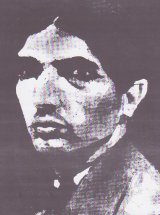U.Porto Memory
University of Porto Famous Alumni
Armando Basto
 |
Armando Basto 1889-1923 Painter, cartoonist, sculptor and decorator |
 Armando Pereira Basto was born in Porto in 1889.
Armando Pereira Basto was born in Porto in 1889.
Here, he studied at the Porto Academy of Fine Arts (1903-10)), where he was taught by José de Brito and Marques de Oliveira. When he was a 4th year graduate student he received the Soares dos Reis Award.
Armando Basto was particularly fond of the cartoonists Rafael Bordalo Pinheiro (1846-1905) and Celso Hermínio (1871-1904), but also of the French and German humorists.
At the beginning of the 20th century, he participated in the groups of "Humorists", "Fantasistas" [Fantasy makers] and "Modernistas", with cartoons and other compositions, in particular the O Lindo Gesto da Revolução [The wonderful gesture of the revolution], which depicted a citizen guarding a bank on 5 October 1910 [Republic Day].
His first individual exhibition, in Porto, depicted individualities from Porto, political themes and observations of the various regional events.
In 1910, he travelled to Paris to continue his studies. Here he enrolled in several courses (Architecture, Drawing and Sculpture), yet he never completed them. He was inspired by masters such as Edouard Manet (1832-1883) and Amadeo Modigliani (1884-1920), and socialized with other Portuguese artists living in Paris, especially with Abel Manta, António Azevedo, José Bragança, Emmercio Nunes, Alberto Cardoso, Francisco Smith, Amadeo Sousa Cardoso and Diogo de Macedo.
 During his stay in Paris, and although he faced serious financial and health problems (he spent some time in hospital in 1914), he frequented the Cité Falguière and Montparnasse, and kept his strong link to the humorist drawing. Together with Aquilino Ribeiro and Leal da Câmara, he launched the magazine Génio Latino, in which Manuel Jardim and Anjos Teixeira also participated. He collaborated in French pamphlets and exhibited his work at the Salon des Humoristes, in the Palais de Glace. During this period, many of his drawings were signed with an "A" in a square, or under the pseudonym Boulemiche.
During his stay in Paris, and although he faced serious financial and health problems (he spent some time in hospital in 1914), he frequented the Cité Falguière and Montparnasse, and kept his strong link to the humorist drawing. Together with Aquilino Ribeiro and Leal da Câmara, he launched the magazine Génio Latino, in which Manuel Jardim and Anjos Teixeira also participated. He collaborated in French pamphlets and exhibited his work at the Salon des Humoristes, in the Palais de Glace. During this period, many of his drawings were signed with an "A" in a square, or under the pseudonym Boulemiche.
When he returned to Portugal, in 1915, he continued to paint and do graphic works.
In 1916, he was the animator of the Salão dos Fantasistas do Porto, where, in the previous year, he had tried to establish a group of independent artists. Two years later, he exhibited his work again in Porto and in Lisbon, where he tried, to succeed in 1923.
 Despite his short artistic career, he still had time to run the humorist newspapers "Coruja", "A Folia" and "Lúcifer afilhado", and to collaborate in "O Riso" and "O Monóculo", which he had helped to found, and also in "Ilustração Portuguesa".
Despite his short artistic career, he still had time to run the humorist newspapers "Coruja", "A Folia" and "Lúcifer afilhado", and to collaborate in "O Riso" and "O Monóculo", which he had helped to found, and also in "Ilustração Portuguesa".
He was the author of the book cover "Teoria da Indiferença", by António Ferro (1920), painted urban landscapes full of visual elements, for instance the Portrait of Dr. Pimentel, also called "O meu violão, que não tem cordas, só serve para isto", in 1918, and landscapes. At the end of his life, he produced some architecture works.
The illustrator and great cartoonist died in Minho, in 1923, from tuberculosis.
(Universidade Digital / Gestão de Informação, 2010)
Last updated: 2016-06-20 Webpage created on: 2024-07-27 13:10:29 Complaint Portal